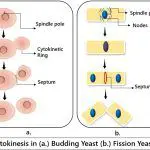Cytokinesis and karyokinesis are significant steps in the cell cycle. The term 'Cyto' refers to the cytoplasm, and 'kinesis' refers to the movement. Cytokinesis is the process involving the division of the cytoplasm of a cell. On the other side, the word 'Karyon' means nucleus, and 'kinesis' is movement. Thus, karyokinesis depicts the nuclear division or the segregation of … [Read more...] about Difference Between Cytokinesis and Karyokinesis
Zoology
Difference Between Sympathetic and Parasympathetic Nervous System
The sympathetic & parasympathetic nervous systems are two components of the autonomic nervous system. These are responsible for controlling and manipulating our involuntary actions. We can differentiate SNS and PNS depending on their responsibilities and action potential. The SNS mobilises the body in stressful situations such as danger, sports, and fights. Thus, it … [Read more...] about Difference Between Sympathetic and Parasympathetic Nervous System
Difference Between Exponential and Logistic Growth
The population of any region is characterised with respect to its growth rate. Exponential and Logistic growth models are two typical but important growth models that can be used to track the population's growth rate. Exponential growth is characterised by the rapid expansion of the population that is unaffected by any upper limit. Contrarily, logistic growth refers to a … [Read more...] about Difference Between Exponential and Logistic Growth
Difference Between Gap Junction and Tight Junction
The essential difference between the Gap junction and the Tight junction is that the first one is known to direct channel between cytoplasms of the adjacent cells, while the latter blocks the passage of solutes and water molecules between epithelial layers in vertebrates. Gap junctions are widely spread in the body of vertebrates, while tight junctions are only found in … [Read more...] about Difference Between Gap Junction and Tight Junction
Difference Between Protozoans and Metazoans
The significant difference between the Protozoa and Metazoa is that the Protozoans are single-celled, though the Metazoans are multicellular. Secondly, the former one (Protozoa) belongs to the primitive type while the latter (Metazoans) belongs to the developed type of animal kingdom. Along with the variations in these two, there are few similarities also like, both the … [Read more...] about Difference Between Protozoans and Metazoans




